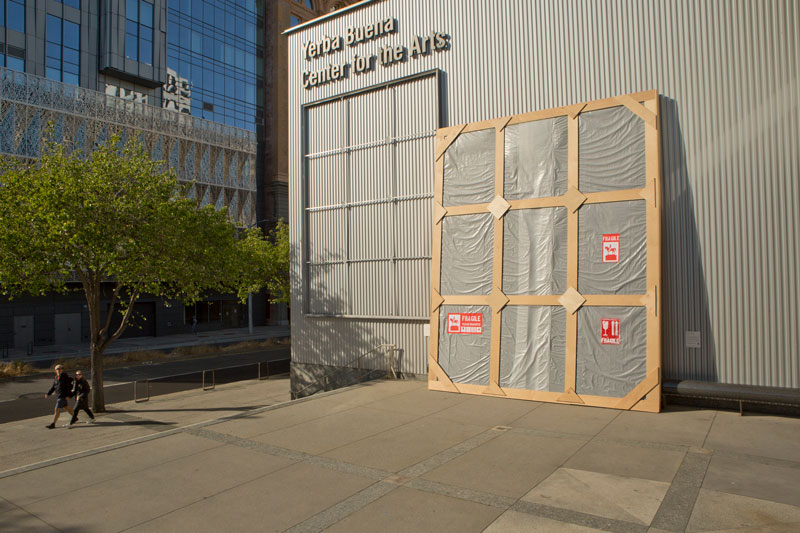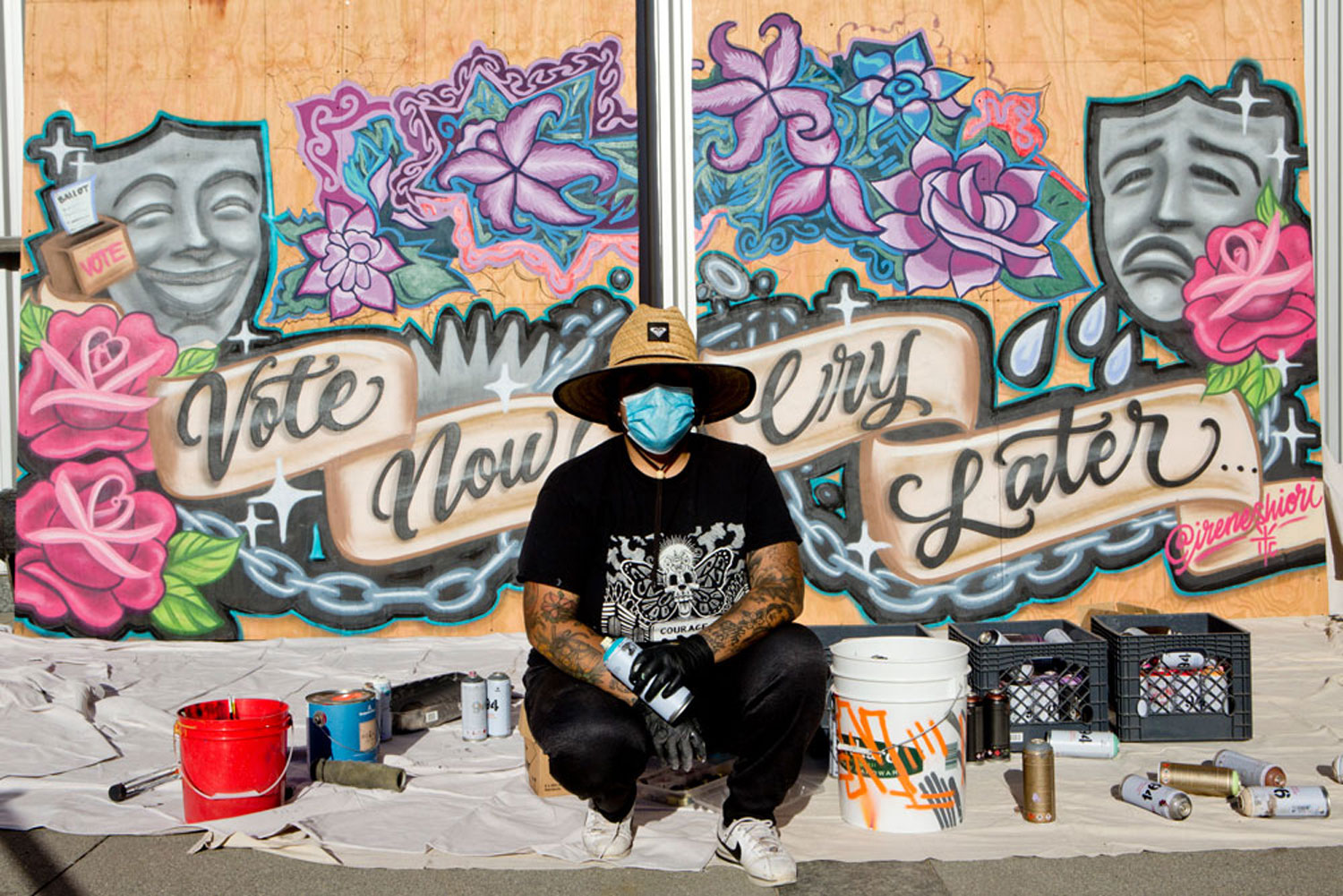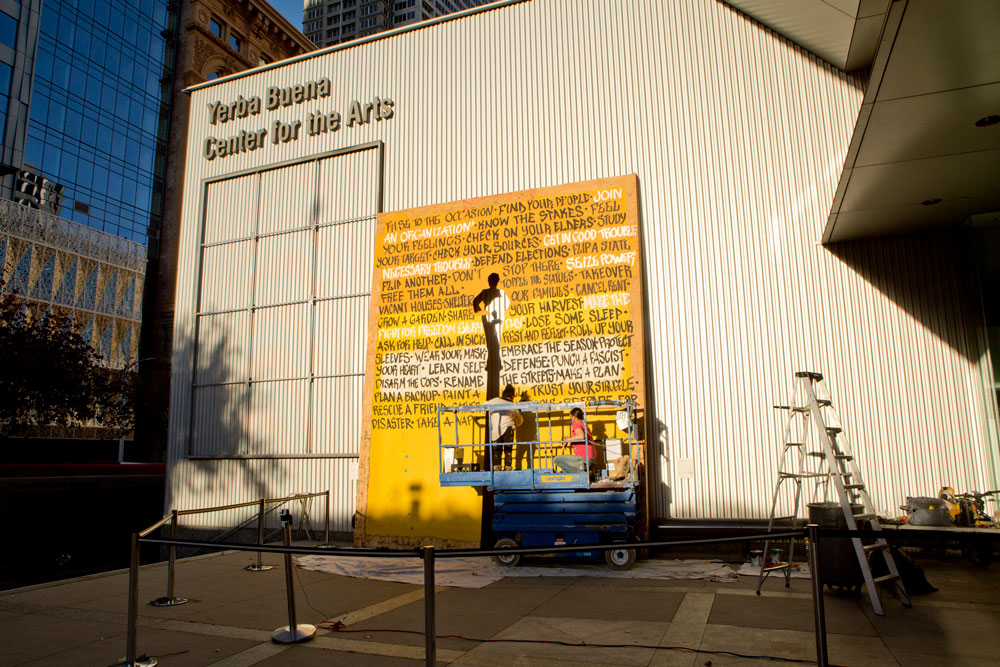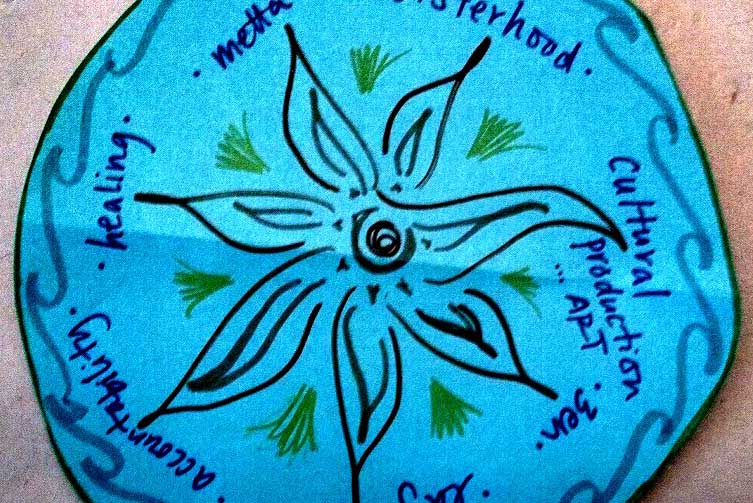Sun July 13th Open 11 AM–5 PM
Inside the Aesthetics of Revolt: Caleb Duarte’s The Monument as Living Memory

At the beginning of October 2020, YBCA’s advertising billboard facing Mission Street was removed, leaving a bare metal structure where promotions for programs and events once hung. This space up to that point had served as a constant and unavoidable public marker of the organization’s identity and the work presented inside, with a form fitted to the scale of the building.
With this gesture, the already-emptied building, thanks to the COVID-19 pandemic, became all the more bare. In its place soon stood a plywood wall of approximately the same size, suggesting a replacement of a tool of commercialization with a symbol of the current moment, a dichotomy of uprisings and closures. At the center of the wall was a cutout of a child standing atop a pedestal, arms outstretched. This cutout referenced the interplay between positive and negative space, what is forefronted and what recedes. In an aesthetic language evoking that of artists Kara Walker, Jay Lynn Gomez, Titus Kaphar, and Nicholas Galanin, the cutout explores who is erased, who is heroicized, and what stories and individuals haunt us through selective history making. As this work evolved, so did the cutout, following our own history making in real time.

Since March 2020, arts institutions have faced an increasingly urgent call from artists, arts workers, and their broader communities to confront the pillars of colonialism and imperialism embedded in the operational systems of even some of the most progressive spaces. This call is not new, but the combination of the pandemic, political turmoil, and movements for racial justice meant that arts institutions could no longer evade demands for equitable change across society. At YBCA, we have been working toward identifying and repairing oppressive practices that exist even in an organization founded with aspirational intentions of diverse programming—a hope tied to 1990s identity politics and a desire on the part of US curators to program underrepresented artists on prominent national platforms such as the 1993 Whitney Biennial, which faced criticism for further marginalizing the artists featured.1 This work continues to be just that—work. Work that is by definition never finished. Work that demands transparency and ongoing critique if it is to be done right.
As part of an organizational shift toward a more equitable programming structure that began prior to the pandemic, YBCA initiated an open call in January 2020 for artist submissions for our Third Street Wavy Wall—a prominent public art and advertising space on YBCA’s campus. Jurors selected Caleb Duarte, whose original submission was based on his work Embassy of the Refugee (2016–ongoing), a collaboration with students from Fremont High School’s Newcomer Education Support and Transition (NEST) program who arrived in the Bay Area as unaccompanied youth from Guatemala seeking asylum.2 Together, Duarte and the students have created performative sculptures across the Bay, including various iterations in YBCA’s exhibitions Bay Area Now 8 (2018) and Suzanne Lacy: We Are Here (2019). Jurors recognized his work as deeply embedded in collaboration, grassroots organizing, and long-term process.
Duarte’s oeuvre unravels the false dichotomy between art and life, demonstrating a model for shifting the power and access that an artist holds and that institutions can learn from. This modeling is perhaps most evident in the founding of EDELO (En Donde Era la Onu, or Where the UN Used to Be), a collaboration with artist Mia Eve Rollow in Chiapas, Mexico. Duarte and Rollow founded this artist residency program as a partial remedy for their dissatisfaction with the US art school experience. EDELO is inspired by Zapatismo, a politically autonomous Indigenous group in Chiapas. Duarte and Rollow saw potential in an application of the Zapatistas’ mode of communal living to artistic practice and everyday life.3 Working with artists and residents in Chiapas and beyond, EDELO rethinks socially engaged art practices through multidisciplinary collaborations. Its diverse projects seek overlap between social struggles and artistic modes of resistance.
“Some institutions and individuals will remain skeptical of the idea that art should ever be activism per se or that it can have any tangible effect on the political landscape. Yet all societal institutions are impacted by the politics of the day, and in our current political climate, it is incumbent upon arts institutions to be socially and politically responsive in a way that encourage nuance, complexity, and civility.” —Anne Ellegood4
When Duarte’s original commission with YBCA was temporarily paused at the onset of the COVID-19 pandemic, he watched as artists looked to the new blank canvases popping up across cities: boarded-up storefronts. Simultaneously, communities were demanding the dismantlement of imperialist monuments as just one aspect of a global movement for Black lives. In his eyes, the growth of new forms of public art through storefronts echoed the destruction of racist, oppressive monuments—building an art of the people while dismantling the art of white supremacy. Duarte recognized this international phenomenon as an opportunity to respond by taking ownership over the architecture and history of YBCA. The prime location of 701 Mission Plaza gave Duarte a space to focus on the role of the artist in summer 2020’s multilayered reckoning. YBCA became a symbol for institutional restructuring, starting with the removal of the organization’s main advertising space.
Replacing the billboard was The Monument as Living Memory, an iterative architectural intervention taking form as a twenty-foot-tall plywood board leaning beside the empty metal framework. Artists from across the Bay Area were invited by Duarte to mark their responses to political and cultural urgencies in real time on the structure. Involving a total of twelve invited collaborators working in series over eight months, the work has spoken to the US border crisis, the 2020 election, the pandemic, and institutional critique through paint, collage, photography, and more. It is a public platform for care—artists integrating and overlapping one another’s work, operating collaboratively while distanced in space and time. The notion of a living memory in the piece’s title alludes to the constant engagement between body, object, and public space, made all the more apparent by the cycles of transformation the artwork has undergone. The living memory stands in opposition to the imposed traditions around monuments as static objects. Operating in some ways closer to an altar, the painting of the artwork’s surface was a ritualistic act or performance paying tribute to the ways culture is created.
Duarte had full artistic control of the project. Through this shifting of curatorial vision and autonomy, he had the capacity to reconfigure the work at a moment’s notice. In this way it could stumble, fail, but also be amended and reworked given its iterative nature. This undertaking provided an opportunity for YBCA to learn and practice shifting power—removing the institution’s usual authority and allowing the artist complete freedom. This work provided an opportunity to explore the institutional limitations of working around cultural shifts in real time, which Duarte and the organization agreed could not be done through an institutional lens. Instead, YBCA’s role was to provide an open platform, to leverage our position to share the work of these artists, and to assure compensation and materials for all involved. Each contributor had full autonomy on content and form, and the lack of preparation between each iteration allowed for a real authenticity. From the perspective of the organization, the outcomes were sometimes unpredictable, but the staff nimbly adjusted to collaborators’ changing schedules, content shifts, and unexpected political and social turns in a world constantly reaching to catch up with itself.
“We need an art that transcends the distanced formality of aesthetics and dares to respond to the cries of the world.” —Suzi Gablik5
Given the work’s site specificity at YBCA, Duarte saw a relationship between the plywood and the painter’s canvas. The latter is tied to a white and Western art history, which Duarte believes has overdetermined our worldview and understanding of visual culture. For students of color, this often means that institutions like art schools deny the validity of their cultural histories. For Duarte, this exclusion took the form of advisors and teachers telling him that his work belonged in cultural centers rather than galleries or museums, leading him to move to Chiapas to found EDELO.

On October 12, 2020, The Monument as Living Memory officially began. As his first collaborators, Duarte selected Urgent Art, a loose group of refugee youths seeking asylum from Guatemala, now living in Oakland. Urgent Art grounded the piece in Indigenous motifs: floral interpretations of Mayan textiles and embroideries worn on Indigenous People’s Day. Their contribution demonstrated Indigenous resistance and the overturning of monuments to build true community narratives.
Two weeks later, on October 23, Duarte invited Bay Area visual and tattoo artist Irene Shiori to create a contribution around the prevailing anxieties leading up to the November 2020 election. Shiori framed the work by Urgent Art with the phrase “Vote now, cry later,” based on “Smile now, cry later,” a Chicano saying on viewing life as both a tragedy and a comedy, originally taken from Greek mythology and popularized by incarcerated tattoo artists. Shiori’s work sought to remind viewers that we all have tangible actions to take as we face a decisive political moment.
By November 5, two days after the election, the world still did not know who would be the next US president. Duarte invited artist and activist David Petrelli to speak to the bated breath echoing throughout the nation. Petrelli chose a small gesture, adding a short quote from political activist Yuri Kochiyama above Urgent Art and Shiori’s work: “Remember consciousness is power.”
Pancho Pescador’s contribution followed on November 12, representing a rebirth and a refusal. Finding nuance in the figure of the political reactionary, Pescador employed strategies from magical realism to create a figure of a divine feminine who might transform the traumas of the election cycle into something new. She cradles a breastfeeding child and is surrounded by elements of otherworldly galaxies.

At this moment in the artwork’s journey, Duarte chose to change the central cutout (the figure of the child) to a silhouette of the politician and voting rights activist Stacey Abrams. Duarte’s gesture recognized the crucial work of Abrams, Deborah Scott, Helen Butler, Nsé Ufot, Tamieka Atkins, and many more who continue to fight voter suppression. Soon after Duarte added Abrams’s image, and on the same day, Georgia turned blue and the US Capitol was attacked. Shifts in power were happening all around us, and Abrams’s silhouette became a representation of a particular historic moment.
While Duarte’s work had been transforming outside of the YBCA building, elementary school students from SoMA attending socially-distanced classes were walking past the evolving work each day. Recognizing their interaction with it, Duarte invited YBCA teaching artist Fred Alvarado and his students to build their own monuments atop the work. They used this opportunity to think about representation and self-empowerment. The students placed their own portraits atop pedestals alongside the cutout of Abrams, thus manifesting monuments for and of themselves.

“[Marxist theater] does not pretend to provide definitive solutions for esthetic problems. What it does pretend to do is to make theater possible again in our country. And with it goes the intention to go on thinking that theater is worthwhile.” —Augusto Boal6
In December 2020, Duarte chose to reset the work with an intervention that emphasized the site specificity of The Monument as Living Memory. Addressing the artwork as inherently institutional, given its setting and funding, he took a critical look at canonical art history, the institutions that support it, and their frequent divorcement from cultural histories. Finding inspiration in Mark Rothko’s search for something beyond the market that can still exist on the canvas, Duarte applied a Rothko-esque backdrop to the cutout of Abrams. This blending of art history and a leading cultural and political figure brought to the fore the dichotomies that the project intentionally provokes. How can abstract art and the aesthetics of revolt come together? Can they exist in service to one another, in productive tension?
Bay Area muralists layered their immediate concerns atop Duarte’s “reset.” Stela Ones partially covered Duarte’s work with a memorial to her brother Jesse, who passed away at the age of twenty-three. Then on January 20, 2021, Inauguration Day, Cece Carpio and Tina Bartolome reminded the public that our societal transformation is far from complete. Taking inspiration from poet Tim Blunk’s 1987 work “for comrades who ask, ‘what is to be done?’ during this particular historical conjuncture, a (partial) list of practical things to do,” they covered The Monument as Living Memory with instructions on how to build systemic change from the ground up. Their instructions were clear and simple: “share your harvest,” “rename the streets,” “heal your wounds,” and, of course, “paint a wall.” Between Blunk’s lines, Carpio and Bartolome wove directives by fellow freedom fighters from various historical moments, connecting fights against oppression across time and space.
Artists Sarah Siskin, KeeNa RoMano, and Rivka Louissaint likewise looked to past freedom fighters to connect our present day with a lineage of resiliency. Inspired by the Black Panther Party’s Ten-Point Program, each artist looked at point five—“We want education for our people that exposes the true nature of this decadent American society. We want education that teaches us our true history and our role in the present-day society”—as a foundation for their contribution.7 Together, their works interwove over two weeks and sought to challenge the art historical canon, the exclusivity of arts institutions that perpetuate this oppressive history, and the imperialist roots of non-Western artifacts.

While the work continued to evolve, Duarte had traveled to Tijuana, Mexico, to build a performance and sculptural project with families living in refugee tent camps at the US-Mexico border. Working with artist ambassadors (a performative and fictional title developed for Duarte’s ongoing project Embassy of the Refugee) from Haiti, Guatemala, Nicaragua, El Salvador, Mexico, and Honduras, he organized public performances and sculptures of imaginary homes to tell the stories of this autonomous community living near the border and awaiting entrance to the United States for asylum.
Returning to San Francisco in April 2021, Duarte reached out to three day-labor workers in the Mission District to assist him with the work’s next transformation. Together they painted BLACK LIVES MATTER over the existing work. Duarte used a palette of dark black and gray to convey a sense of disappearance. This suggests a softening of the movement, or an erasure by not actualizing the cultural and political shifts necessary to confront the oppressive and violent history of the United States. The faded Black Lives Matter signage on a leaning wall painted by anonymous workers is a performative sculptural act that addresses one of the many causes of violence against Black and brown bodies, namely the continued exploitation of their invisible labor.

This visual softening also echoes the way institutional structures commoditize cultural movements and the aesthetic of revolt. By repacking the visual markers of grassroots organization—for example by disassociating the artwork from its community context and placing it in a white cube, or by co-opting aesthetics for capital gain or branding—institutions soften the sense of urgency for change. The radical work produced by the movement becomes digestible to the mainstream, and therefore less likely to disturb the comforts of white supremacy. Duarte chose to end the first chapter of The Monument as Living Memory by building on this domino effect.
“But the truth is, I don’t think art or artists are what will save the world. Only a new way of being can do that—one that knits people together through an inspired ethos of generosity and caring, and a return to the root idea of what it means to make value-centered, moral choices.” —Suzi Gablik8
After eight months of transformations of The Monument as Living Memory, we can now look back and interrogate the artwork as an evolving piece and ask—Did it work? Can institutions fruitfully work with the aesthetics of revolt and meaningfully address their own colonialist histories in the process? To close out this experiment, Duarte chose to have YBCA preparators wrap the work as if for transit. Acknowledging the literal and metaphorical packaging of culture through plastic and plywood, the final transformation of the work is perhaps pessimistic, in its emphasis on the idea that even this could be displaced from institution to institution and become further disconnected from the artistic communities who cared for it through trying and tiring times. Or perhaps it is a hopeful gesture, suggesting that this action of shifting power and forefronting artistic autonomy can spread.

Beneath the plastic covering, viewers can still see the words BLACK LIVES MATTER. This blurring speaks to the perseverance of the cultural and political movements that resist this erasure. These movements do not seek validation from arts institutions, and are regardlessly neglected by the gatekeepers of cultural preservation until they become digestible to a largely white audience through decontextualization. The suppression that occurs inside the bare galleries of art institutions further removes the intentions of the movement from its objects, thus obscuring the aesthetics of revolt. What and who is remembered is filtered through the institution, leaving the broad public with a fragmented understanding of our collective capacity for revolution.
The Monument as Living Memory is a monument to our moment—living and ever-changing. For the rest of 2021, Duarte has decided to hand over leadership of the work to artists working in relationship with YBCA. Stay tuned for more information on the next chapter of The Monument as Living Memory.
Special thanks to Caleb Duarte, Martin Strickland, and Lindsey Westbrook for their generous editorial support.
Fiona Ball is YBCA’s Curatorial Project Manager and has worked with YBCA staff and Caleb Duarte to co-organize The Monument of Living Memory.
- Roberta Smith, “At the Whitney, A Biennial with a Social Conscious,” New York Times, March https://www.nytimes.com/1993/03/05/arts/at-the-whitney-a-biennial-with-a-social-conscience.html; Charles Gaines, The Theater of Refusal: Black Art and Mainstream Criticism (Irvine: Fine Arts Gallery of the University of California, Irvine, 1993), 20.
- Read more at the artist’s website: http://www.calebduarte.org/embassy/4594227569.
- See Raquel de Anda, “Interview with Caleb Duarte of EDELO Residencia,” in Collective Situations: Readings in Contemporary Latin American Art, 1995–2010, ed. Bill Kelley and Grant Kester (Durham, NC: Duke University Press, 2017), 43–57.
- Anne Ellegood, response in As Radical, as Mother, as Salad, as Shelter: What Should Art Institutions Do Now?, ed. Dushko Petrovich and Roger White (Brooklyn: Paper Monument, 2018), 35.
- Suzi Gablik, The Reenchantment of Art (New York: Thames and Hudson, 1995), 100.
- Augusto Boal, Theater of the Oppressed (London: Pluto Press, 1979), 164.
- For more on the Ten-Point Program see the Black Lives Matter syllabus: http://www.blacklivesmattersyllabus.com/wp-content/uploads/2016/07/BPP_Ten_Point_Program.pdf.
- Suzi Gablik, Has Modernism Failed? (New York: Thames and Hudson, 2004), 17.



